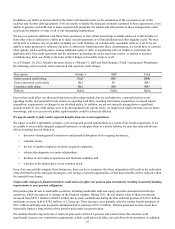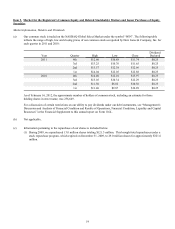Windstream 2011 Annual Report Download - page 87
Download and view the complete annual report
Please find page 87 of the 2011 Windstream annual report below. You can navigate through the pages in the report by either clicking on the pages listed below, or by using the keyword search tool below to find specific information within the annual report.15
customer is subject to no higher than interstate access charges, we will incur additional access revenue reductions. In addition,
as mentioned above, we cannot estimate the amount of these reductions until we can quantify the amount of traffic based on
information obtained from long distance carriers.
We are complying with the revised signaling requirements and paying appropriate access charges for traffic we originate in
VoIP format and deliver to other telephone companies for termination. If other companies do not comply with this portion of
the order and continue to be compensated at higher rates, we will be at a competitive disadvantage.
In 2011, we received approximately 6 percent of our revenues from state and federal USF, and any material adverse
regulatory developments with respect to these funds could adversely affect our profitability.
We receive state and federal USF revenues to support the high cost of providing affordable telecommunications services in
rural markets. Such support payments constituted approximately 6 percent of our revenues for the year ended December 31,
2011. A portion of such fees are based on relative cost and access line counts, and we expect receipt of such fees to decline as
we continue to reduce costs and lose access lines. Pending regulatory proceedings could, depending on the outcome, materially
reduce our USF revenues.
Texas is currently reviewing its USF funding mechanism, and any adverse developments could significantly affect our USF
revenues. Texas state USF revenues were $94.2 million in 2011.
We are required to make contributions to state and federal USF programs each year. Current state and federal regulations allow
us to recover these contributions by including a surcharge on our customers' bills. If state and/or federal regulations change, and
we become ineligible to receive support, such support is reduced, or we become unable to recover the amounts we contribute to
the state and federal USF programs from our customers, our results of operations and financial condition would be directly and
adversely affected.
Our operations require substantial capital expenditures, and if funds for capital expenditures are not available when
needed, this could affect our service to customers and our growth opportunities.
We require substantial capital to maintain our network, and our growth strategy will require significant capital investments for
network enhancements and build-out. During 2011, we incurred $702.0 million in capital expenditures, and we expect to incur
in excess of $950.0 million in capital expenditures in 2012 due to our significant investments in fiber-to-the-tower and other
initiatives. See "Liquidity and Capital Resources" for our expected capital expenditures in 2012.
We use a significant portion of our cash generated from operations to pay dividends to stockholders, which could limit our
ability to make the capital expenditures necessary to support our business needs and growth plans. We expect to be able to fund
required capital expenditures from cash generated from operations. However, other risk factors described in this section could
materially reduce cash available from operations or significantly increase our capital expenditure requirements. If this occurs,
funds for capital expenditures may not be available when needed, which could affect our service to customers and our growth
opportunities.
Our substantial debt could adversely affect our cash flow and impair our ability to raise additional capital on favorable
terms.
As of December 31, 2011, we had approximately $9,150.4 million long-term debt outstanding, including current maturities. We
may also obtain additional long-term debt to meet future financing needs or to fund potential acquisitions, subject to certain
restrictions under our existing indebtedness, which would increase our total debt. Our substantial amount of debt could have
negative consequences to our business. For example, it could:
• Increase our vulnerability to general adverse economic and industry conditions;
• Require us to dedicate a substantial portion of cash flows from operations to interest and principal payments on
outstanding debt, thereby limiting the availability of cash flow to fund future capital expenditures, working capital and
other general corporate requirements;
• Limit our flexibility in planning for, or reacting to, changes in our business and the telecommunications industry;
• Place us at a competitive disadvantage compared with competitors that have less debt; and
• Limit our ability to borrow additional funds, even when necessary to maintain adequate liquidity.
























